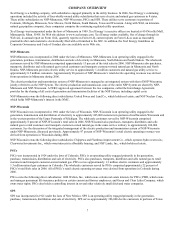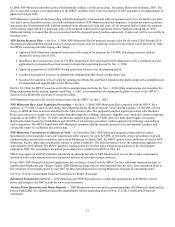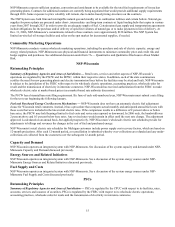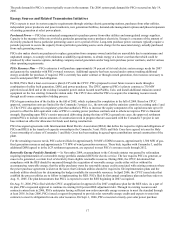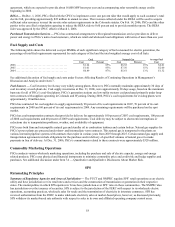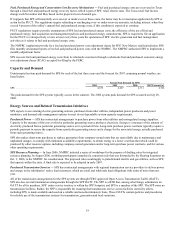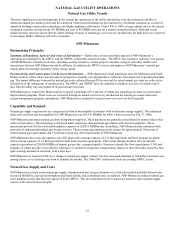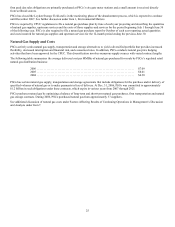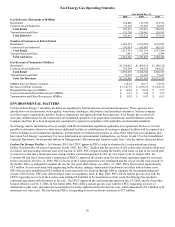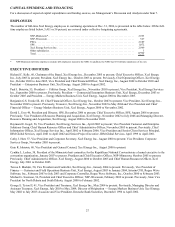Xcel Energy 2006 Annual Report Download - page 27
Download and view the complete annual report
Please find page 27 of the 2006 Xcel Energy annual report below. You can navigate through the pages in the report by either clicking on the pages listed below, or by using the keyword search tool below to find specific information within the annual report.17
The peak demand for PSCo’s system typically occurs in the summer. The 2006 system peak demand for PSCo occurred on July 19,
2006.
Energy Sources and Related Transmission Initiatives
PSCo expects to meet its system capacity requirements through existing electric generating stations, purchases from other utilities,
independent power producers and power marketers, new generation facilities, demand-side management options and phased expansion
of existing generation at select power plants.
Purchased Power — PSCo has contractual arrangements to purchase power from other utilities and nonregulated energy suppliers.
Capacity is the measure of the rate at which a particular generating source produces electricity. Energy is a measure of the amount of
electricity produced from a particular generating source over a period of time. Long-term purchase power contracts typically require a
periodic payment to secure the capacity from a particular generating source and a charge for the associated energy actually purchased
from such generating source.
PSCo also makes short-term purchases to replace generation from company-owned units that are unavailable due to maintenance and
unplanned outages, to comply with minimum availability requirements, to obtain energy at a lower cost than that which could be
produced by other resource options, including company-owned generation and/or long-term purchase power contracts, and for various
other operating requirements.
PSCo Resource Plan — PSCo estimates it will purchase approximately 39 percent of its total electric system energy needs for 2007
and generate the remainder with PSCo-owned resources. Additional capacity has been secured under contract making additional
energy available for purchase, if required. PSCo currently has under contract or through owned generation, the resources necessary to
meet its anticipated 2007 load obligation.
In 2004, PSCo filed a least-cost resource plan (LCP) with the CPUC. PSCo proposed to meet future resource needs through a
combination of utility built generation, DSM, and power purchases. The CPUC approved PSCo’s plan to construct a 750 MW
pulverized coal-fired unit at the existing Comanche power station located near Pueblo, Colo. and install additional emission control
equipment on the two existing Comanche station units. The CPUC also called for PSCo to acquire the remaining resource needs
through an all-source competitive bidding process.
PSCo began construction of the facility in the fall of 2005, which is planned for completion in the fall of 2009. Based on CPUC
approval, construction costs are limited for the Comanche 3 project (i.e., the new unit and the emission controls on existing units 1 and
2). The CPUC also approved a regulatory plan that authorizes PSCo to increase the equity component of its capital structure up to 60
percent to offset the debt equivalent value of PSCo’s existing power purchase contracts and to otherwise improve PSCo’s financial
strength. Depending upon PSCo’s senior unsecured debt rating during the time of PSCo general rate cases, the approved settlement
permits PSCo to include various amounts of construction work in progress that are associated with the Comanche 3 project in rate
base without an offset for allowance for funds used during construction.
PSCo has signed agreements with Intermountain Rural Electric Association (IREA) that define the respective rights and obligations of
PSCo and IREA in the transfer of capacity ownership in the Comanche 3 unit. PSCo and Holy Cross have agreed to terms for Holy
Cross ownership of a share of Comanche 3 and Holy Cross has been making its agreed-upon contributions toward construction of the
plant.
For the remaining resource needs, PSCo selected bids for approximately 30 MW of DSM resources, approximately 1,300 MW of gas-
fired generation resources and approximately 775 MW of wind generation resources. These bids, together with Comanche 3, and the
additional DSM agreed to in the LCP settlement agreement, are expected to meet PSCo’s resource needs through 2012.
Renewable Energy Portfolio Standards — In November 2004, an amendment to the Colorado statutes was passed by referendum
requiring implementation of a renewable energy portfolio standard (RES) for electric service. The law requires PSCo to generate, or
cause to be generated, a certain level of electricity from eligible renewable resources. During 2006, the CPUC determined that
compliance with the RES should be measured through the acquisition of renewable energy credits either with or without the
accompanying renewable energy; that the utility purchaser owns the renewable energy credits associated with existing contracts where
the power purchase agreement is silent on the issue; that Colorado utilities should be required to file implementation plans and the
methods utilities should use for determining the budget available for renewable resources. In April 2006, the CPUC issued rules that
establish the process utilities are to follow in implementing the RES. PSCo filed its first annual compliance plan under these rules on
Aug. 31, 2006. The plan demonstrates that PSCo is expected to meet the RES beginning in 2007 as required.
On Aug. 31, 2006, PSCo filed with the CPUC an application for approval of its 2007 compliance plan for the RES rules. As a part of
its plan, PSCo requested approval to continue its existing 0.60 percent RES adjustment rider. Through its existing resources and
contracts entered into in 2006, PSCo anticipates having sufficient non-solar renewable energy resources to meet the standard through
at least 2016. In June 2006, PSCo issued a request for proposal to provide solar renewable energy credits and expects to enter into
contracts to meet its obligation for on-site solar resources. On Sept. 1, 2006, PSCo executed a twenty-year solar power purchase


